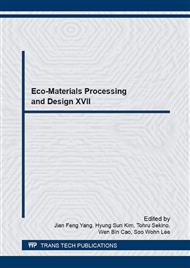p.50
p.56
p.61
p.68
p.73
p.79
p.84
p.89
p.95
Photoluminescence Properties of the Magnetoplumbite-Type BaMg6Ti6O19:Mn4+ and Spinel-Type Mg2TiO4:Mn4+
Abstract:
Mn4+-doped magnetoplumbite-type BaMg6Ti6O19 and spinel-type Mg2TiO4 red phosphors were synthesized by a solid-state reaction. BaMg6Ti6O19:Mn4+ and Mg2TiO4:Mn4+ were formed as main phase above 1200 oC. Although the emission peak of BaMg6Ti6O19:Mn4+ and Mg2TiO4:Mn4+ were almost the same, the excitation peak of BaMg6Ti6O19:Mn4+ and Mg2TiO4:Mn4+ were different. The 4A2→4T1 transition peak of Mg2TiO4:Mn4+ shifted to a shorter wavelength side than that of BaMg6Ti6O19:Mn4+ and 4A2→4T2 shifted to a longer wavelength side. The crystal field splitting energy of Mg2TiO4:Mn4+ was lower than that of BaMg6Ti6O19:Mn4+. By the additional of R block, the racah parameter B increased and C decreased. Although the increase of B causes a blue-shift of the emission wavelength and the decrease of C causes a red-shift of the emission wavelength, PL emission wavelength was little different due to the influence of both racah parameter. Thus, it was suggested that the existence of R block results in a difference of photoluminescence properties.
Info:
Periodical:
Pages:
73-78
Citation:
Online since:
August 2016
Authors:
Keywords:
Price:
Сopyright:
© 2016 Trans Tech Publications Ltd. All Rights Reserved
Share:
Citation:


